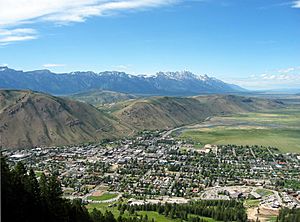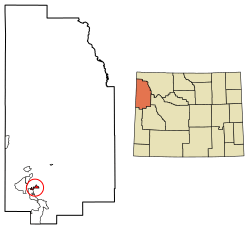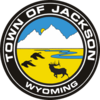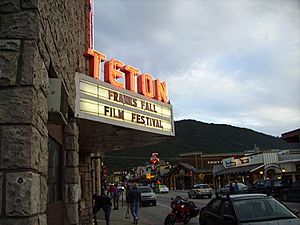Jackson, Wyoming facts for kids
Quick facts for kids
Jackson, Wyoming
|
||
|---|---|---|

Jackson viewed from Snow King Mountain in June 2007
|
||
|
||
| Nicknames:
Jackson Hole, The Hole, JH
|
||

Location of Jackson in Teton County, Wyoming
|
||
| Country | United States | |
| State | Wyoming | |
| County | Teton | |
| Incorporated | 1914 | |
| Named for | David Edward Jackson | |
| Government | ||
| • Type | Mayor–council | |
| Area | ||
| • Town | 2.99 sq mi (7.74 km2) | |
| • Land | 2.96 sq mi (7.66 km2) | |
| • Water | 0.03 sq mi (0.08 km2) | |
| Elevation | 6,237 ft (1,901 m) | |
| Population
(2020)
|
||
| • Town | 10,760 | |
| • Density | 3,598.67/sq mi (1,390.18/km2) | |
| • Metro | 31,464 | |
| Time zone | UTC−7 (Mountain (MST)) | |
| • Summer (DST) | UTC−6 (MDT) | |
| ZIP codes |
83002
83001 83014 83025 83013 83012 83414 83011 |
|
| Area code(s) | 307 | |
| FIPS code | 56-40120 | |
| GNIS feature ID | 1604404 | |
| Website | jacksonwy.gov | |
Jackson is a fun resort town in Teton County, Wyoming, United States. It's a popular spot for tourists! In 2020, about 10,760 people lived there.
Jackson is the biggest town in Teton County and where the county government is located. It's often called Jackson Hole, which is the name of the beautiful valley it sits in. People love to visit Jackson because it's super close to awesome ski resorts like Jackson Hole Mountain, Snow King Mountain, and Grand Targhee. It's also near amazing national parks like Grand Teton National Park and Yellowstone National Park.
Contents
History
Jackson was first home to several Native American tribes. These included the Shoshoni, Crow, Blackfeet, Bannock, and Gros Ventre people. In the early 1800s, explorers and fur trappers like John Colter traveled through this area. Colter visited Jackson Hole in the winter of 1807-1808. Other famous mountain men, such as Jim Bridger, Jedediah Smith, and William Sublette, also explored the valley. They even named many places in the area! The valley itself was named after David Edward Jackson, who spent a winter by Jackson Lake.
In 1871 and 1872, William Henry Jackson took the first photos of the Teton Range and Yellowstone. His pictures, along with sketches by Tom Moran, helped convince the U.S. Congress to protect Yellowstone. This led to Yellowstone National Park becoming the first National Park in 1872. Later, Grand Teton National Park was created in 1929. It grew much larger in 1950 when John D. Rockefeller Jr. bought and donated over 30,000 acres of land.
The town of Jackson was officially named in 1894 and became an incorporated town in 1914. You can still see some of the original buildings around the Town Square today.
A cool fact: in 1920, the town of Jackson elected an all-woman government! This included the mayor and town council. They then appointed women to other important roles like town marshal and treasurer.
The first ski rope tow in the area was built in 1937 at Teton Pass. Snow King Resort, another ski area, was started in 1930. Today, Teton County has three great ski resorts. These are Jackson Hole Mountain Resort, Grand Targhee Ski and Summer Resort, and Snow King Resort.
Jackson is the main town in Teton County. Most of the land in Teton County is owned by the government. In fact, 97% of the 2,697,000 acres are federal or state-owned. Only a small part, less than 3%, is privately owned.
In 2009, Jackson was recognized as a "Preserve America Community." This means the town works hard to protect its history. It uses its historic places to help the economy and encourages people to learn about its past.
Geography
Jackson is located high up, about 6,237 feet above sea level. The town covers about 2.95 square miles. Most of this area is land, with a small part being water.
Mountains surround Jackson. To the west are the Teton Mountains, which are very famous and beautiful. Many visitors come just to see them! To the east are the Gros Ventre Mountains. These mountains are older and cover a huge area of wilderness.
Flat Creek, a small river that flows into the Snake River, runs right through the town.
Climate
Jackson has a climate with warm summers and very cold winters. Because it's in a narrow river valley, Jackson gets more snow and rain than most of Wyoming. It also has higher humidity for much of the year.
The high elevation causes big differences between day and night temperatures. The coldest temperature ever recorded was -52°F in December 1924. The hottest was 101°F in July 1934. On average, the temperature drops below freezing (32°F) about 236 days a year. It gets below 0°F about 34 days a year.
Jackson gets a lot of snow, averaging about 78.2 inches each year. The most snow in one month was 56.0 inches in January 1969!
| Climate data for Jackson, Wyoming, 1991–2020 normals, extremes 1905–present | |||||||||||||
|---|---|---|---|---|---|---|---|---|---|---|---|---|---|
| Month | Jan | Feb | Mar | Apr | May | Jun | Jul | Aug | Sep | Oct | Nov | Dec | Year |
| Record high °F (°C) | 55 (13) |
58 (14) |
70 (21) |
79 (26) |
90 (32) |
95 (35) |
101 (38) |
98 (37) |
93 (34) |
87 (31) |
67 (19) |
66 (19) |
101 (38) |
| Mean maximum °F (°C) | 43.6 (6.4) |
46.5 (8.1) |
56.3 (13.5) |
67.9 (19.9) |
76.8 (24.9) |
83.7 (28.7) |
89.9 (32.2) |
88.2 (31.2) |
83.3 (28.5) |
74.0 (23.3) |
55.7 (13.2) |
44.7 (7.1) |
90.0 (32.2) |
| Mean daily maximum °F (°C) | 26.1 (−3.3) |
30.4 (−0.9) |
40.2 (4.6) |
50.2 (10.1) |
60.3 (15.7) |
69.8 (21.0) |
79.1 (26.2) |
78.0 (25.6) |
68.1 (20.1) |
54.5 (12.5) |
37.6 (3.1) |
26.2 (−3.2) |
51.7 (11.0) |
| Daily mean °F (°C) | 16.2 (−8.8) |
19.9 (−6.7) |
29.2 (−1.6) |
38.0 (3.3) |
45.9 (7.7) |
53.8 (12.1) |
60.2 (15.7) |
58.9 (14.9) |
50.5 (10.3) |
39.7 (4.3) |
26.7 (−2.9) |
16.5 (−8.6) |
38.0 (3.3) |
| Mean daily minimum °F (°C) | 6.3 (−14.3) |
9.3 (−12.6) |
18.2 (−7.7) |
25.8 (−3.4) |
31.5 (−0.3) |
37.8 (3.2) |
41.4 (5.2) |
39.8 (4.3) |
32.8 (0.4) |
24.9 (−3.9) |
15.8 (−9.0) |
6.8 (−14.0) |
24.2 (−4.3) |
| Mean minimum °F (°C) | −19.3 (−28.5) |
−15.6 (−26.4) |
−2.0 (−18.9) |
12.8 (−10.7) |
18.4 (−7.6) |
27.6 (−2.4) |
32.5 (0.3) |
29.8 (−1.2) |
20.7 (−6.3) |
10.2 (−12.1) |
−2.6 (−19.2) |
−17.3 (−27.4) |
−24.5 (−31.4) |
| Record low °F (°C) | −50 (−46) |
−48 (−44) |
−49 (−45) |
−5 (−21) |
5 (−15) |
12 (−11) |
24 (−4) |
18 (−8) |
5 (−15) |
−9 (−23) |
−27 (−33) |
−52 (−47) |
−52 (−47) |
| Average precipitation inches (mm) | 1.45 (37) |
1.43 (36) |
1.33 (34) |
1.46 (37) |
1.83 (46) |
1.61 (41) |
1.10 (28) |
1.14 (29) |
1.59 (40) |
1.57 (40) |
1.37 (35) |
1.76 (45) |
17.64 (448) |
| Average snowfall inches (cm) | 19.1 (49) |
15.6 (40) |
9.2 (23) |
4.2 (11) |
0.6 (1.5) |
0.0 (0.0) |
0.0 (0.0) |
0.0 (0.0) |
0.1 (0.25) |
2.0 (5.1) |
11.0 (28) |
16.4 (42) |
78.2 (199.85) |
| Average precipitation days (≥ 0.01 in) | 12.3 | 10.1 | 8.8 | 9.3 | 11.0 | 9.7 | 7.3 | 7.6 | 8.0 | 8.7 | 9.5 | 13.6 | 115.9 |
| Average snowy days (≥ 0.1 in) | 10.8 | 9.1 | 5.5 | 2.4 | 0.4 | 0.0 | 0.0 | 0.0 | 0.1 | 1.7 | 5.4 | 11.4 | 46.8 |
| Source 1: NOAA | |||||||||||||
| Source 2: National Weather Service | |||||||||||||
Population and People
| Historical population | |||
|---|---|---|---|
| Census | Pop. | %± | |
| 1900 | 59 | — | |
| 1910 | 264 | 347.5% | |
| 1920 | 307 | 16.3% | |
| 1930 | 533 | 73.6% | |
| 1940 | 1,046 | 96.2% | |
| 1950 | 1,244 | 18.9% | |
| 1960 | 1,437 | 15.5% | |
| 1970 | 2,688 | 87.1% | |
| 1980 | 4,511 | 67.8% | |
| 1990 | 4,472 | −0.9% | |
| 2000 | 8,647 | 93.4% | |
| 2010 | 9,577 | 10.8% | |
| 2020 | 10,760 | 12.4% | |
| source: | |||
In 2010, there were 9,577 people living in Jackson. There were 3,964 households, which are groups of people living together.
Most people in Jackson are White (about 79.8%). About 15.2% are from other backgrounds. Many people (27.2%) are of Hispanic or Latino heritage.
The average age in Jackson in 2010 was about 31.9 years old. About 18% of the people were under 18. Many adults (43.8%) were between 25 and 44 years old.
Economy and Jobs
Jackson's economy is very strong, mostly because of tourism. Many people visit the town, which helps local businesses.
The main jobs in Jackson are in:
- Arts, entertainment, and recreation (like ski resorts and museums)
- Hotels and restaurants
- Construction
- Retail (stores)
- Education and healthcare
Because so many tourists visit, Jackson has lots of cool shops and restaurants. You can find art galleries, jewelry stores, and clothing shops, especially around the town square.
Fun Things to Do and See
Jackson is full of exciting places and events!
- Center for the Arts: This place helps support artists in town. It was built in 2007 and is a hub for creative activities.
- Elkfest: Every spring, Jackson hosts an Elk Antler Auction. Boy Scouts of America help sell antlers collected from the nearby National Elk Refuge. The money helps the Boy Scouts and the refuge.
- Grand Targhee Resort: This ski resort is about an hour away, on the other side of the Teton Mountains. It opened in 1969 and is a great place for skiing and summer fun.
- Grand Teton Music Festival: If you love classical music, this is for you! It's a seven-week festival held every summer in Jackson.
- Grand Teton National Park: This huge national park is only about 5 miles from Jackson. It includes the stunning Teton Mountain Range and covers about 310,000 acres. Over two million tourists visit it each year!
- Jackson Hole Mountain Resort: Opened in 1966, this resort is 12 miles north of Jackson. It has very steep slopes and one of the biggest vertical drops for skiing in North America (4,139 feet!).
- National Elk Refuge: This refuge is right next to Jackson. It protects one of the largest elk herds in the country. In winter, you can take horse-drawn sleigh rides to see the elk up close!
- National Museum of Wildlife Art: This museum overlooks the National Elk Refuge. It has many amazing artworks that show wildlife. There's also a cool outdoor trail with sculptures.
- Snow King Mountain Resort: This was Jackson's first ski resort. It's on the edge of town and offers challenging slopes. It has over 400 acres of skiable land with chairlifts and a gondola.
- Snow King Observatory and Planetarium: Located at the top of Snow King Mountain, this is a great place to learn about stars and space.
- Yellowstone National Park: The very first national park in the U.S. is less than 60 miles from Jackson! Yellowstone is mostly in Wyoming but also stretches into Idaho and Montana. About four million people visit it every year.
Education
Kids in Jackson go to schools run by the Teton County School District #1. This district covers all of Teton County.
Some of the schools in Jackson include:
- Jackson Elementary School (grades K–5)
- Colter Elementary School (grades K–5)
- Munger Mountain Elementary (grades K–5)
- Jackson Hole Middle School (grades 6–8)
- Jackson Hole High School (grades 9–12)
- Summit Innovations High School (grades 9–12)
- Jackson Hole Classical Academy (grades K–12)
- Jackson Hole Community School
- Journeys School
Jackson also has a public library, which is part of the Teton County Library system. The old Teton County Library building, built in 1938, is a rustic log cabin. It's so special that it's on the National Register of Historic Places! This building now holds the Huff Memorial Library.
Getting Around
Jackson is located where several major roads meet: US 26, US 89, US 189, US 191, and Wyoming Highway 22.
The town has its own airport, Jackson Hole Airport. It's the busiest airport in Wyoming! There's also a public bus system called "The START Bus." It helps people get around Jackson, to Teton Village, and to nearby communities. You can even find airport buses that go to Salt Lake City.
Jackson Hole Economic Policy Symposium
Since 1978, an important meeting called the "Jackson Hole Economic Policy Symposium" has been held in Jackson. This is a big event where important financial leaders, bankers, and experts from all over the world come together to talk about the economy.
Famous People from Jackson
Many well-known people have lived in or are connected to Jackson:
- Sandra Bullock (born 1964), actress
- Jimmy Chin (born 1973), professional climber, photographer, and Oscar-winning film director (he directed Free Solo)
- Harrison Ford (born 1942), actor
- John Franklyn Mars (born 1935), businessman and heir to the Mars candy company
- Travis Rice (born 1982), professional snowboarder
- Christy Walton (born 1949), widow of John T. Walton, whose father founded Walmart
See also
 In Spanish: Jackson (Wyoming) para niños
In Spanish: Jackson (Wyoming) para niños




